Louisiana Pickins // Growing Seasons
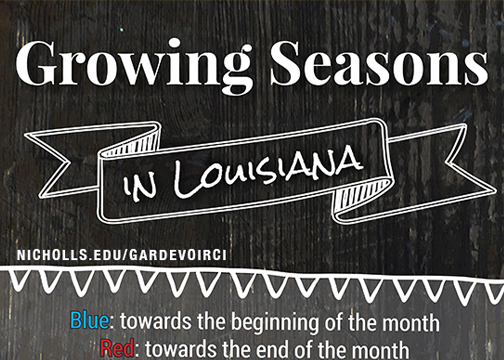
A Cajun Staple // Gumbo

by Andetrie Vicks, Staff Writer Today when family and friends in Louisiana get together to enjoy each other’s company the style of cooking is still CAJUN/CREOLE. Traditional comfort foods are on the menu, like red beans and rice, fried catfish and most importantly gumbo. Gumbo is extremely diverse and every family makes it slightly different with their preference of meats, spices, and thickener. In the beginning this tasty elixir was made by the people of South Louisiana, but it was just a simple soup using meats and vegetables cooking in water. Gumbo history reveals that African American imported okra found its way into the Louisiana kitchens, and provided gumbo with its name; Gumbo is the African word for okra. It was discovered that okra boosted the flavor, but more importantly it added some texture in the way of a thickening agent. Later people found that flour browned in pig lard added a great color, texture and taste. This is where roux first made its appearance and changed gumbo history. Since then roux has become the dominant agent to thicken this famous Louisiana dish as nothing can match the colors and flavors as deep. Another way of thickening is by adding the ground leaves from the sassafras tree: Filé. This fine seasoning was adopted from the local Choctaw Indians. The powder is added right before serving and adds a hearty taste that gumbo lovers seek. Gumbo differs from bowl to bowl but one thing always remains the same, it is a Louisiana classic enjoyed by many. This is a recipe for a chicken sausage gumbo, one of the many variations of this dish. Chicken and Sausage Gumbo Yield8 servcings INGREDIENTS 1 cup vegetable oil 1 cup all-purpose flour 2 onions chopped 1 green bell pepper chopped 1 yellow bell pepper chopped 4-5 celery stalks chopped 3 cloves garlic minced 1 lb Andouille or smoked sausage chopped and browned 1-2 lbs chicken cooked 10 cups chicken broth 2 bay leaves 1 tbsp Kitchen Bouquet 1 tbsp Cajun seasoning 2 tbsp parsley white rice Instructions 1 Heat the oil in a large pot over medium heat, add in the flour and whisk constantly until the mixture is smooth and brown. This forms the Roux. The roux will burn very easy if it’s not moving. Once roux is brown add onions, and cook for 5 minutes. Add the bell peppers and celery, and cook for 5 more minutes. Stir in the Kitchen Bouquet, garlic, sausage and Cajun seasoning and cook another 5 minutes. Add the chicken broth and bay leaves to the pot and bring it to a boil. Let the gumbo simmer for one hour. After an hour add parsley and cooked chicken to the gumbo and simmer 1 more hour Remove excess oil from the top of gumbo. Serve hot over white rice. People often add Filé, hot sauce, and salt and pepper to their individual bowls.
Dance In The Kitchen ‘Till The Morin Light // Recipes
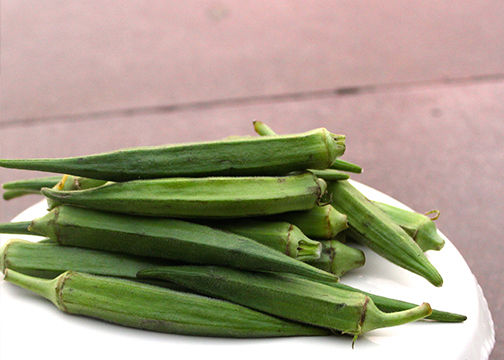
by Katie Fletcher, Special Sections Editor The kitchens of South Louisiana are blessed with some of the best chefs in the world. The food is just as spicy and diverse as the people who prepare it. It’s southern food with extra flavor, extra calories, and extra love. Everybody’s grandma makes the greatest gumbo, and everybody’s dad boils the best crawfish. Here are a couple of things that make the food down here a little bit different. THE TRINITY It all starts with the holy trinity. I’m not talking about religion; I’m talking about the sacred mixture of onions, bell peppers, and celery. These three vegetables are the backbone to many South Louisiana dishes. The smell of the trinity cooking can instantly make a mouth water and a crowd form in the kitchen around the old cast iron pot it’s cooking in. The trinity is usually, but not always broken down into two small onions, one large bell pepper, and three to four ribs of celery. The trinity is chopped and sautéed to create the base for jambalaya, gumbo, étouffée, stew, sauce piquante, and so many other Louisiana favorites. MEASUREMENTS Recipes in South Louisiana are passed down from generation to generation. Whether they are scribbled down or memorized they are held close to the hearts of the people that enjoy them. When a recipe is written down it is often times hard to recreate because the measurements are not the average teaspoon, cup, or oz. My grandma, like many other Cajuns, has her own measuring system. I have tried countless times to cook her recipes but they never come out the same. There’s something about the way she does things that makes everything taste just right. Over the years I have watched her cook and her measurements can be roughly translated to: “A pinch of salt.” About a teaspoon, she uses this measurement when she’s adding salt to bread dough, or a pot of food. “Equal parts flour and oil.” About ¾ cup of each to make a roux for a Gumbo or stew, it gets a little tricky when it’s an extra large gumbo for the whole family. “A handful or two.” About a cup to two cups, this can be anything from nuts in a bread pudding to crawfish tails in a bisque. “A dash of. “ About ¼ teaspoon, usually referring to spicy ingredients like Cayenne and Tabasco. “Just enough to cover.” About two cups of rice and three and a half cups of water. To transfer the rice to the pot she always uses a plastic parade cup, that’s about as far as measuring cups go for “A heaving spoonful” About a tablespoon, she uses this measurement when talking about sugar, but she always sneaks in a little more. Her motto: “It can never be too sweet.” MEAT AND SEAFOOD Food doesn’t get much more local than Louisiana. From a young age, children are taught how to peel crawfish and shrimp. They know to how to ‘pinch the tails’ before they know how to tie their shoes. Food here is fresh and seasonal. Fish are caught the same day they are fried. Louisiana is covered in water making it the perfect place for fishing. People spend hours fishing their favorite spots to bring home ice chests of fish to clean and eat. Crabs are picked apart to get the ‘good meat’ for soups and stews. Oysters are very popular and can be served many different ways. A common way is too shuck it and eat it raw straight from the shell with hot sauce or ketchup. The meat around here can get kind of wild. Sure we eat chicken, pork and beef, but to some South Louisianans turtle, alligator, and frog legs are delicacies. It’s not uncommon for chili to be made with deer meat or for duck to be served with rice and gravy. People take pride in catching and hunting their food and are always willing to throw it in a pot and share it with family and friends. Cuisine in Louisiana is still cooked the way it has been for years, slow and seasoned. It’s made with love and served in huge portions. Invite people over and enjoy one of these recipes. Louisiana food is an experience that allows people to stop from their busy day, sit down with family, and enjoy food that is rich with flavor and soul.
Louisiana // Seasons

by Brooke Pizani, Photographer & Special Sections FOR THE MAJORITY OF THE WORLD, there are four seasons: Winter, Spring, Summer and Fall. For Louisiana, it may seem we skip winter or have an extended summer, but we identify our seasons by what each change of the weather means to us. Ask a native of South Louisianan what the four seasons are and they may answer: Mardi Gras, Crawfish, Sno-ball and Football. WINTER Carnival season starts on January 6th, The Feast of the Epiphany, and lasts through Fat Tuesday, also known as Mardi Gras. People wait all year to celebrate what makes Louisiana unique from the rest of the country. King cakes and beads can be found on every street. People schedule their days around parades and tend to drink as much as they eat. Nobody else can say they had off of school for Mardi Gras! Everywhere else, it’s just a Tuesday, but in South Louisiana is a holiday that is highly anticipated. SPRING During crawfish season, pots are filled with seafood, boiling water, spicy seasoning, and anything else Cajuns see fit. Crawfish are bought fresh by the sack and shared among family and friends. Everybody comes casual and leaves full with the smell of crawfish lasting on their skin for hours after. The Catholic season of Lent, which starts on Ash Wednesday, the day after Mardi Gras, asks for practicing Catholics to abstain from meat on every Friday until Easter Sunday. SUMMER Sno-ball season beats the summer heat for many Louisianans of all ages. It’s called a sno-ball never a sno-cone or shaved ice; those don’t exist in Southern Louisiana. Sno-balls are sold at stands on the side of the road and are just too much of a temptation for people to pass up. There is no dress code required and people are often seen in swim wear and flip flops while they take a break from summer activities such as fishing. When the sno- ball is first served it can be eaten with a spoon, but one minute in the Louisiana sun turns it into an icy liquid that you drink with a straw. Sno-balls are served in a Styrofoam cup and flavored with sweet syrups in hundreds of flavors that leave your tongue stained. FALL And last but certainly not least, football season. Also known as tailgating season. Bars and restaurants will be just as packed as churches on a Sunday from roughly August to January. Both college football on Saturdays, and professional football on Sundays will bring together family and friends. Food and football go hand in hand especially if the Tigers or Saints are having a good season. From potluck style football parties to parking lot BBQs fans stay full to cheer on their favorite team.
In Bags // Sharing the Bounty
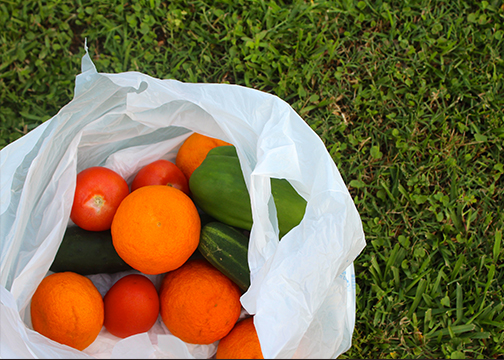
By Claire LeBeouf, Staff Writer “Don’t forget your bag of groceries!” “Y’all go pick some oranges.” “I picked that from my garden this morning.” LOCALLY GROWN. These are all things you will hear in South Louisiana when it comes to local food. It is common down south to grow produce and sell it, but it is more common to give it away to friends, family, and neighbors. Citrus trees line people’s back yards with branches of juicy fruit begging to be picked. Fresh cucumbers and tomatoes are plucked straight from the vine and eaten with salt and pepper. Plastic grocery bags are the universal way to transport produce from house to house. Janet Tauzin, a grandmother of four, enjoys passing down this South Louisiana tradition. “I know my grandkids love when we send them home with fruits and vegetables that I get from my neighbor’s garden,” Tauzin says. In spring, lemon trees are in full bloom just in time for crawfish season. Homegrown lemons go perfectly with all the fixings that go into the boiling pot. People put in hours of hard work in their gardens planting, pruning, and picking. But they are willing to let others try what they have grown year after year. Now that’s southern hospitality, Cajun recycling and good eating!
What does Chu-Chut mean?
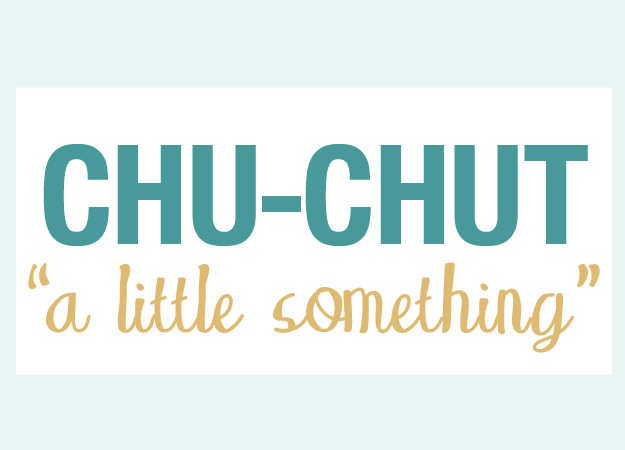
By Torri Sepulvado, Special Sections Editor What it is??? A Chu-Chut is a thing. What thing you might wonder? It’s anything you want it to be. A Chu-Chut is the thing that you can’t remember the name of in the middle of a conversation. It is a southern Louisiana saying that, as a transplant, I have come to love. It’s one of my favorite new words and I think it needs to be spread to the rest of the country. It keeps the conversation flowing, and somehow everyone knows what you’re talking about even though you never said. Let me give you an example: Girl: “Today I taught my nephew how to tie his shoes.” Friend: “How old is he?” Girl: “He’s 6, but you know that chu-chut on the end of the laces?” Friend: “Oh yea! The little plastic thing.” Girl: “Yes! That thing.” When the “chu-chut” came into use I don’t know, but whoever came up with it I want to shake their hand. I think it is such a clever word.
Creole and Cajun . . . What’s the Difference?

By Torri Sepulvado, Special Sections Editor Creole and Cajun are sometime used interchangeably, but in reality the words refer to two separate groups of people. Creoles are descendants from the upper-class French and Spanish colonists that came from Europe. The word Creole eventually included slaves born in the colonies and free people of color. Cajuns are descendants of the Acadians, French natives who settled in Acadia, or Nova Scotia. They were forced to relocate to South Louisiana after their home was taken by the British. There is a distinct difference between the two, especially because during the 18th century these two groups of people were living extremely different lives. The Creoles were mostly inside New Orleans dealing with the growing population and the racism that came from having darker skin. The Cajuns were in the outlying bayous living, for the most part, off of the land. One major difference was the development of the two groups’ food. Cajuns were hunters, and the bayou area provided no shortage of game to hunt. However, the spices and variety of food was limited for the Cajuns so they learned to heavily spice every part of the animal they killed to make the most of it. Creole cuisine was developed in the city by kitchen slaves that had a variety of spices and cooking methods available to create more complex dishes. I’ve heard the difference between a Creole gumbo and a Cajun gumbo is tomatoes. A Creole gumbo is tomato based. Each group grew into the distinct cultures you are able to see and experience in the New Orleans area.
The Rougarou
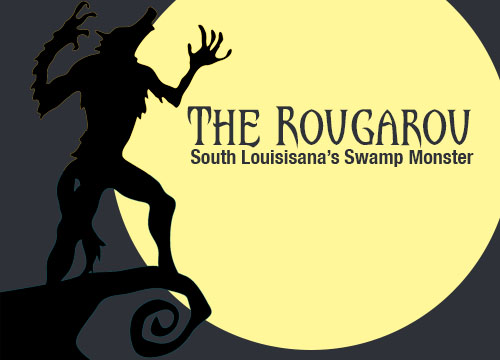
Torri Sepulvado, Special Sections Editor The Swamp Monster The Rougarou is South Louisiana’s own swamp monster. It is a common folktale parents use to keep children from crawling out of their beds at night and causing mischief. According to Brian Head, a Cajun from Berwick, the Rougarou “looks like a half wolf man with big teeth ready to tear into a man.” The Rougarou is a legend that evolved from the French legend of loup-garou. “Loup” is the French word for wolf, and “garou” meaning man. The Rougarou is the story of the werewolf. Some even claim that a man becomes the Rougarou if he breaks from Catholic religious tradition. Larry Faulk, a Catholic Cajun from Morgan City, says his mom used to tell him that if he broke the rules for Lent he would turn into the Rougarou. And at the top of the story is Chase Boudreaux from Lockport talking about the Rougarou legend. Spooky Howling Werewolf poster halloween promo | Free vector by Vector Open Stock
Punishment Now and Then

by Harmony Hamilton, Managing Editor Hiram Torres, born in 1930 with a twin brother and the father of five, gives his thoughts on spanking and the way kids are being brought up in this generation. “I got many spankings coming up, but it didn’t hurt me…not enough to where I got bruised or abused, but I felt it. That is one thing that I notice so much about today’s parents, they don’t spank their kids. “I also think that the parents aren’t devoting enough time participating in their kids’ lives. “When my kids were growing up and there was a function at school, we went. Because I feel as though if you don’t show your child that you are interested in what is going on in his school, then he’s going to say, ‘Hey my parents don’t care.’ “It may be because both parents are working. But at least one should find the time. Going to open houses, school activities, or field trips… I don’t think the parents devote enough time to that.“
Southern Sayings
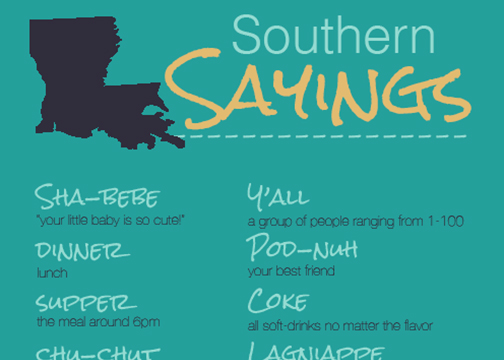
by Torri Sepulvado, Special Sections Editor “Aldnfgtgskf jskdyybfk kfuhbdl!” Gibberish is what I sometimes heard when I first moved to South Louisiana from North Louisiana — Shreveport to be exact. The accents and words are so varied in that for a newcomer it’s almost impossible to understand. Slowly but surely I learned that dinner meant lunch and cher-bebe, pronounced sha-bebe, meant “awe so cute.” There was a steep learning curve, but as I became more comfortable I found myself falling into the new slang I learned.
